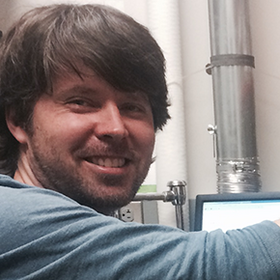

312 Church Street SE
Minneapolis, MN 55455
United States
Joseph
Muretta
Research statement
The goal of structural biophysics is to show how biomolecular structure explains physiology. Toward this goal, high-resolution crystallography and cryo-EM studies reveal the inner structure of some of life’s most complicated machinery. But even the highest resolution protein structures are static snap shots and without directly measuring how proteins move in vitro and in cells and tissues, it is imposible to say exactly how structure gives rise to physiology. My work bridges the boundaries between biophysics and cell biology to address this problem in structural biology. The focus of this work is to determine how disease causing and disease associated insults such as mutations and post-translational modifications, change protein dynamics, how this leads to changes in protein function, and how this changes cellular physiology. I currently focus on two research areas. The first is cardiac myosin and its role in inherited and acquired heart disease; the second area is the structural dynamics of mitotic kinesins and their role in mitosis and cancer. I use a combination of spectroscopic approaches, performed in solution and in live cells, to measure changes in protein structure, via time-resolved FRET. I then correlate these changes with protein biochemical kinetics, to determine how the dynamics of individual structural elements are coordinated with active enzyme cycling.
The cornerstone of this work is an innovative method termed transient time-resolved FRET, (TR)2FRET for short. (TR)2FRET measures nanosecond scale time-resolved FRET repeatedly every millisecond during transient biochemical reactions. We use (TR)2FRET to determine how structural transitions are coupled to biochemical kinetics in proteins. For example, we have used this approach to investigate how force generating structural transitions in myosins and kinesins are coupled to the biochemical kinetics of ATP hydrolysis, and how this coupling is altered in diseases like inherited cardiomyopathies and cancer. We use the information gained from these studies to develop FRET based drug discovery platforms to identify small molecules that target allosteric structural transitions in our favorite proteins. The small molecules that we discover are leads for drug development to help patients in the clinic.
The work that I do is important because it tells us how the machinery of life works, how chemical energy is coupled to mechanical energy in the cell, how polymorphisms change structural equilibrium and protein allosteric transitions, and how we can directly target allostery to treat disease using FRET based drug discovery campaigns directed toward changes in protein structure.
Selected publications
Muretta, JM, JA Rohde, DO Johnsrud, S Cornea, and DD Thomas. Direct real-time detection of the structural and biochemical events in the myosin power stroke. Proc Natl Acad Sci USA. 2015 (accepted Oct, 9).
2. Muretta JM, J Yonggun, S Gross, JA Major, DD Thomas, and SS Rosenfeld. The structural kinetics of switch-1 and the neck linker explain the functions of Kinesin-1 and Eg5. Proc Natl Acad Sci USA. 2015 (accepted Oct, 26).
3. Darshan Trivedi, JM Muretta, AM Swenson, JP Davis, DD Thomas, and CM Yengo. Direct Measurements of the Coordination of Lever Arm Swing and the Catalytic Cycle in Myosin V. Proc Natl Acad Sci USA. 2015 (accepted Oct, 15).
4. Petersen, KJ, KC Peterson, JM Muretta, SE Higgins, GD Gillispie, and DD Thomas. 2014. Fluorescence lifetime plate reader: resolution and precision meet high-throughput. Rev Sci Inst .
5. Muretta, JM, Behnke-Parks WM, Major J, Petersen KJ, Goulet A, Moores CA, Thomas DD, and SS Rosenfeld. 2013. Loop L5 Assumes Three Distinct Orientations During the ATPase Cycle of the Mitotic Kinesin Eg5. J. Biol. Chem. 2013.
6. Muretta, JM and DD Thomas. 2013. A Mutation that Causes Hypertrophic Cardiomyopathy Increases Force Production in Human Beta-Cardiac Myosin. Proc Natl Acad Sci USA. 2013. (Commentary)
7. Muretta, JM, KJ Petersen, and DD Thomas. Direct real-time detection of the actin-activated power stroke within the myosin catalytic domain. Proc Natl Acad Sci USA. 2013.
8. Trivedi, D; JM Muretta, A Swenson, DD Thomas, C Yengo. Magnesium impacts myosin V motor activity by altering key conformational changes in the mechanochemical cycle. Biochemistry. 2013.
9. Cornea RL, SJ Gruber, EL Lockamy, JM Muretta, D Jin, J Chen, R Dahl, T Bartfai, KM Zsebo, GD Gillispie, DD Thomas. High-throughput FRET assay yields allosteric SERCA activators. J Biomol Screen. 2013;18(1):97-107.
10. Guhathakurta P, E Prochniewicz, JM Muretta, MA Titus, DD Thomas. Allosteric communication in Dictyostelium myosin II. J Muscle Res Cell Motil. 2012;33(5):305-12. PMCID: 3600821.
11. Thomas, DD, JM Muretta, BA Colson, R Mello, and D Kast. 2012. Spectroscopic probes of muscle proteins. In Comprehensive Biophysics, Editor-in-Chief HE Egelman, Amsterdam, Elsevier. 226-250
12. Wilson DJ, C Shi, BP Duckworth, JM Muretta, U Manjunatha, YY Sham, DD Thomas, CC Aldrich. A continuous fluorescence displacement assay for BioA: an enzyme involved in biotin biosynthesis. Anal Biochem. 2011;416(1):27-38. PMCID: 3135573.
13. Muretta JM, A Kyrychenko, AS Ladokhin, DJ Kast, GD Gillispie, DD Thomas. High-performance time-resolved fluorescence by direct waveform recording. Rev Sci Instrum. 2010;81(10):103101. PMCID: 2980540.
14. Muretta JM, CC Mastick. How insulin regulates glucose transport in adipocytes. Vitam Horm. 2009;80:245-86.
15. Muretta JM, I Romenskaia, CC Mastick. Insulin releases Glut4 from static storage compartments into cycling endosomes and increases the rate constant for Glut4 exocytosis. J Biol Chem. 2008;283(1):311-23.
16. Muretta JM, I Romenskaia, PA Cassiday, CC Mastick. Expression of a synapsin IIb site 1 phosphorylation mutant in 3T3-L1 adipocytes inhibits basal intracellular retention of Glut4. J Cell Sci. 2007;120(Pt 7):1168-77.